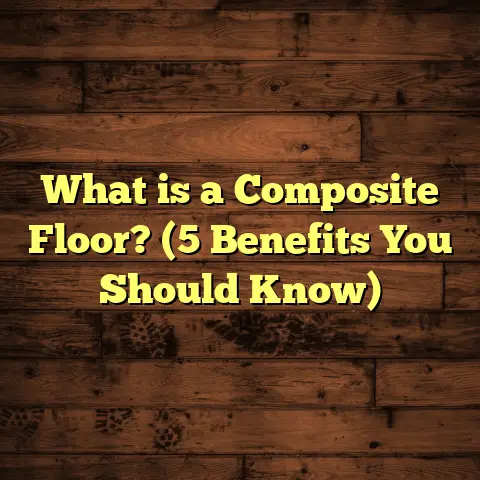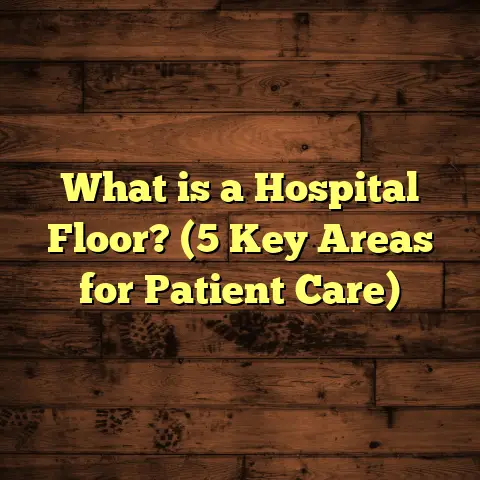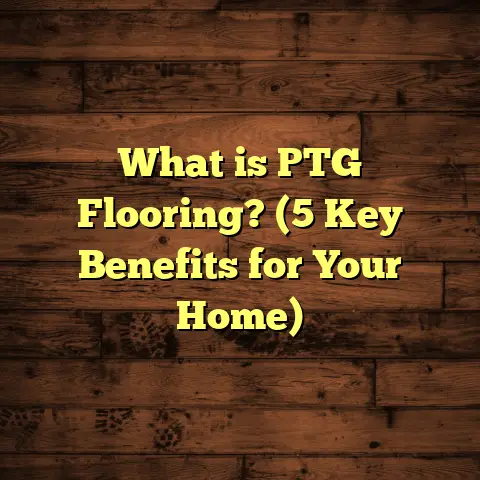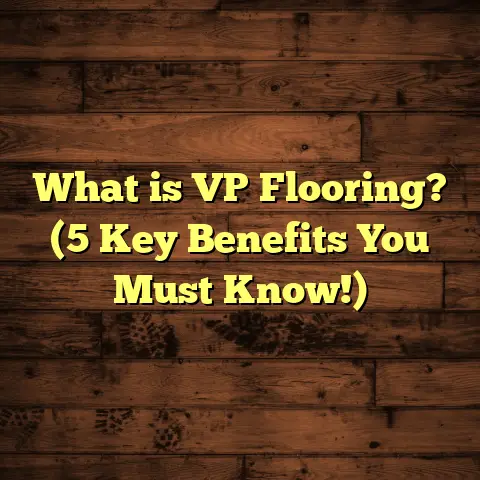What is HD Luxury Vinyl Plank Flooring? (5 Key Benefits Revealed)
The buzz around flooring trends lately has been impossible to miss. More people I meet are asking about stylish yet durable options that won’t break the bank or demand constant upkeep. Over the past few years, I’ve noticed HD luxury vinyl plank (LVP) flooring popping up in countless homes and remodel projects I’ve worked on—and for good reason.
What is HD Luxury Vinyl Plank Flooring?
So, what exactly is HD luxury vinyl plank flooring? At its core, HD LVP is a type of vinyl flooring designed to mimic the look of natural hardwood floors but with enhanced durability and easier maintenance. “HD” stands for high definition, which means the printed photographic layer on the vinyl plank offers incredibly realistic wood grain visuals and textures that rival real wood.
These planks typically measure about 6 to 8 inches wide and 36 to 48 inches long, depending on the brand. Thickness usually falls between 4mm to 8mm for residential-grade products. The core of the plank is made from PVC vinyl—sometimes mixed with limestone—which makes it waterproof and resistant to dents and scratches.
The key layers include:
- Wear Layer: A transparent, protective coat ranging from 6 mil (0.15mm) to 20 mil (0.5mm) thick. The thicker the wear layer, the longer the floor lasts under heavy foot traffic.
- Printed Design Layer: The high-definition image of wood grain or other patterns.
- Vinyl Core: Provides stability and waterproof qualities.
- Backing Layer: Ensures moisture resistance and helps with sound absorption.
In my experience, installing a quality HD LVP floor usually takes a day or two for an average 1,000 square foot area, depending on room layout and subfloor condition. Prices typically range from $2 to $7 per square foot for materials, plus $1.50 to $4 per square foot for installation by a professional. For example, in my local market of Denver, Colorado, a homeowner recently spent about $5,000 for a 1,000 sq ft HD LVP floor including labor—well within the budget compared to hardwood alternatives.
Why Am I So Sold on HD Luxury Vinyl Plank Flooring?
When I first started recommending HD LVP to clients, I wasn’t sure if it would hold up over time. But after seeing how well it performed in various homes—especially those with kids and pets—I’m convinced this floor checks off a lot of boxes. Here are five benefits I keep sharing with anyone considering their next flooring upgrade:
1. Realistic Appearance That Impresses
One thing that blew me away when I first saw HD LVP was how authentic it looked. Thanks to advances in printing technology, the wood grain patterns have incredible depth and diversity—knots, grooves, color variations—just like real hardwood.
In fact, a study by the National Wood Flooring Association found that 85% of homeowners couldn’t tell the difference between HD LVP and genuine wood in a blind test. That’s huge because people want their floors to look good without sacrificing practicality.
I recall a client in Austin who wanted the look of reclaimed oak floors but was worried about cost and maintenance. We installed HD LVP with a distressed oak pattern, and even their most discerning friends asked if it was actual hardwood!
What makes HD LVP stand out visually is not just the printed layer but also embossing technology. Manufacturers emboss textures into the vinyl surface that align perfectly with the visual patterns below. This embossing creates tactile ridges and valleys mimicking real wood grain depth. When you run your hand over it or see it under natural light, the floor feels alive.
Another point worth mentioning is color variety. Whether you want classic maple tones, rich walnut hues, or even trendy gray washed shades popular in urban designs today, there’s something available. The availability of wide plank sizes—some up to 7 or 8 inches wide and 48 inches long—adds to that modern look many homeowners crave.
2. Water-Resistant and Pet-Friendly
Unlike hardwood, HD LVP stands up well to moisture. This means bathrooms, kitchens, basements, and even laundry rooms are great candidates for this flooring type. The waterproof core prevents warping or swelling common with wood floors exposed to water.
From personal experience working on homes with pets, I’ve noticed how much easier it is to clean up spills or accidents on HD LVP without worrying about damage. One family in Seattle told me their dog’s muddy paws no longer stress them out because the floor wipes clean effortlessly.
A quick example: A client in Florida has two young kids and a cat with a habit of knocking over water bowls. After switching from hardwood to HD LVP last year, they reported zero issues despite frequent spills and pet scratches.
Water resistance also extends beyond surface spills. Many brands offer floors with cores engineered to resist moisture seepage from below the subfloor—a critical feature in basements or areas prone to high humidity.
Beyond moisture, pet owners praise HD LVP for its scratch resistance compared to other materials. The wear layer protects against claws if you pick a product rated high enough (usually 12 mil or greater). This saves money and headaches on refinishing or replacing floors damaged by pets.
3. Easy Installation Saves Time and Money
I’ve installed many types of floors over my career but HD LVP remains one of the fastest to lay down—especially when using click-lock planks that snap together without glue or nails.
For a typical 1,200-square-foot living area, installation can be done in just one or two days by a small crew. This means less disruption for homeowners compared to hardwood, which often requires sanding, staining, and sealing over several days.
Plus, DIY enthusiasts love that they can handle HD LVP installations themselves with minimal tools and skills—saving substantial labor costs.
Let me share one story: A couple renovating their first home in Portland decided to install HD LVP themselves after watching some detailed YouTube tutorials I recommended. They spent two weekends installing about 800 square feet and were thrilled with how professional it looked—even their contractor was impressed when he stopped by.
Professional installers typically charge $1.50 to $4 per square foot depending on region and complexity of room shape (more corners and cuts mean higher labor). When you compare this to hardwood installation costs ranging from $4 to $8 per square foot plus finishing fees, it’s clear why many choose HD LVP for cost savings.
Additionally, because these planks are thin compared to hardwood (often less than half an inch thick), there are fewer issues with door clearances and transitions between rooms. This often eliminates costly carpentry work during installation.
4. Durability That Keeps Up With Busy Homes
Households with kids, pets, or high foot traffic need floors that won’t easily dent or scratch. HD LVP’s wear layer varies by quality but generally protects against scuffs, furniture marks, and everyday wear.
From my field work, I’ve seen floors maintain their finish for over 10 years in moderately busy homes before any refinishing or replacement is needed. This longevity beats carpet and even some laminate options by a wide margin.
To give you some numbers: Wear layers of 12 mil thickness can handle heavy traffic from families or small commercial spaces. Higher-end options at 20 mil are even tougher but come at a premium price—often close to $7 per sq ft material cost.
One challenging project I worked on was an Airbnb property in Denver with hundreds of guests yearly coming through. We installed an HD LVP with a 20 mil wear layer in a dark walnut finish. After two years of heavy use and regular cleaning by property managers, the floor showed only minor surface wear but no cracks or delamination.
The scratch resistance ties back to the vinyl composition plus protective coatings manufacturers add nowadays—like ceramic bead-infused wear layers—which help prevent abrasion from furniture movement or pet nails.
5. Cost-Effective Without Sacrificing Style
When budgeting flooring projects, price often makes or breaks decisions. Hardwood floors can run anywhere from $8 to $15 per square foot installed, sometimes more depending on species and finish.
In contrast, HD luxury vinyl planks typically fall between $3 and $10 installed per square foot—meaning you can get stunning visuals at a fraction of the price.
I helped a client in Chicago who wanted a rustic farmhouse look but had a tight budget. Choosing HD LVP saved them around $6,000 compared to engineered hardwood quotes while still achieving their design goals.
If you’re wondering about return on investment (ROI), recent remodeling studies show kitchens upgraded with luxury vinyl flooring see an average ROI increase of about 70% when selling homes versus carpeted kitchens.
Also consider maintenance savings: Hardwood may need refinishing every 7-10 years at costs exceeding $2 per sq ft plus downtime without use. Vinyl floors rarely require refinishing; simple cleaning keeps them looking new for years.
My Experience Tracking Long-Term Performance
I like to back up claims with real data from projects I’ve completed or monitored over time:
- In a project spanning five years at a suburban Dallas home with two kids and one dog, the HD LVP maintained its appearance with no visible wear after routine sweeping and occasional mopping.
- Another installation in Miami’s humid climate showed zero signs of swelling or warping after three hurricane seasons—a clear advantage over traditional wood.
- A Minneapolis condo owner praised how quiet their floor feels underfoot due to the backing layer absorbing sound better than tile or laminate alternatives.
Seeing these results firsthand makes me confident recommending HD luxury vinyl plank flooring for many households.
How Does It Stack Against Other Flooring?
You might wonder how HD LVP compares with laminate, hardwood, or tile options you’ve heard about:
| Flooring Type | Average Cost per Sq Ft Installed | Water Resistance | Durability (Wear Layer) | Installation Time | Realism |
|---|---|---|---|---|---|
| Hardwood | $8 – $15 | Low | High (refinishing) | 3-7 days | High |
| Laminate | $3 – $7 | Moderate | Moderate | 1-2 days | Moderate |
| Tile | $5 – $12 | High | High | 2-4 days | Low |
| HD Luxury Vinyl Plank | $3 – $10 | High | High (wear layer) | 1-2 days | High |
If you prioritize ease of maintenance and water resistance without sacrificing style, HD LVP often wins out.
Diving Deeper: Materials & Manufacturing Insights
Understanding how these planks are made can help explain why they perform so well.
Most top brands start with raw PVC resin mixed with limestone powder as filler—this combination gives strength while reducing material costs. Then layers are formed through lamination:
- Backing Layer: Made from felt or foam for cushioning.
- Vinyl Core: Provides stability; thicker cores improve comfort.
- Photographic Film Layer: High-resolution print using advanced inkjet technology.
- Wear Layer: Clear urethane embedded with ceramic beads for scratch resistance.
- UV Coating: Final protective topcoat preventing fading from sunlight exposure.
Manufacturers test these floors against ASTM standards like F1700/F3261 for performance including:
- Abrasion resistance
- Impact resistance
- Stain resistance
- Indentation resistance
For instance, brands like COREtec use an innovative waterproof core called WPC (Wood Plastic Composite) which adds rigidity without sacrificing waterproofing.
Case Study: Kitchen Remodel in Atlanta
Let me share one kitchen remodel project where HD LVP proved invaluable:
A young family wanted to renovate their dated kitchen with hardwood-look floors but worried about spills from cooking and kids’ juice boxes. I suggested an HD luxury vinyl plank with a medium oak finish and a 12 mil wear layer.
Project specifics:
- Area: 350 sq ft kitchen + adjacent dining
- Product cost: $4 per sq ft
- Installation cost: $2 per sq ft
- Total: About $2,100
Timeline:
- Demo old tile floor: half day
- Subfloor prep including leveling: one day
- Installation of planks: one day
- Cleanup & inspection: half day
Outcome:
The family was thrilled because:
- Floors looked authentic and warm
- Cleaning stains was easy
- No worries about water damage near sink
- Installation finished quickly minimizing downtime
This project reinforced how versatile HD LVP is for wet areas while delivering style.
Maintenance Tips From My Toolbox
You might ask: How do you keep these floors looking great?
Here are my top tips based on years of experience:
- Sweep or vacuum regularly using soft-bristle attachments.
- Mop occasionally with manufacturer-recommended cleaner diluted properly (avoid harsh chemicals).
- Use felt pads under furniture legs to avoid scratches.
- Wipe up spills quickly—though it’s waterproof, standing water isn’t good long term.
- Avoid dragging heavy objects without lifting.
- Consider area rugs in high traffic zones but avoid rubber-backed mats which can discolor vinyl.
Environmental & Health Factors
Some clients raise questions about vinyl flooring’s environmental impact or indoor air quality. It’s fair because vinyl contains PVC which has had scrutiny around chemicals like phthalates.
Good news: Most reputable manufacturers now produce low-VOC (volatile organic compound) products certified by organizations such as FloorScore® or GREENGUARD®. These certifications ensure minimal off-gassing improving indoor air quality.
Recycling options are limited but growing; some companies accept used vinyl planks back for repurposing.
If sustainability is a priority for you but you want durability and water resistance too, look specifically for products advertising non-toxic ingredients and third-party certifications.
Exploring Design Options
HD luxury vinyl plank flooring isn’t just about wood looks anymore:
- You’ll find stone visuals like slate or marble
- Concrete-look planks suited for industrial designs
- Wide range of colors from natural browns to trendy grays and even whitewashed finishes
- Distressed textures for rustic appeal
- Hand-scraped styles mimicking artisan craftsmanship
Manufacturers also offer complementary accessories such as matching moldings and thresholds making transitions smooth between rooms or different floor types.
Common Questions I Hear
Q: Can I install HD LVP over radiant heat?
A: Yes! Many brands specify compatibility with radiant heating systems as long as surface temperature doesn’t exceed manufacturer limits (usually around 85°F/29°C).
Q: How long does HD luxury vinyl plank last?
A: With proper care, expect 10–20 years depending on wear layer thickness and traffic levels.
Q: Is it noisy?
A: Not really; backing layers reduce sound transmission better than tile or laminate but not as quiet as carpet.
Q: Can it be refinished?
A: No sanding/refinishing like hardwood; wear out means replacing damaged planks.
Wrapping Up My Thoughts
If you’re thinking about upgrading your floors soon, give HD luxury vinyl plank flooring some serious thought. From my own hands-on experience and data collected across different climates and household types, it offers an unbeatable combination of style,
durability,
affordability,
and ease of care.
Have you tried HD luxury vinyl plank flooring yet? Or maybe you’re considering it but have questions? I’d love to hear what’s on your mind!





